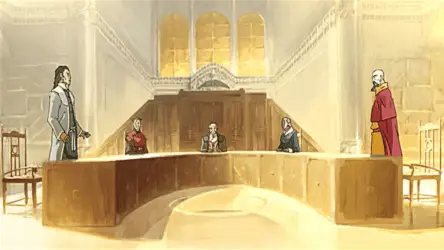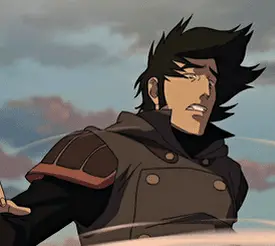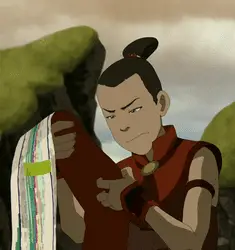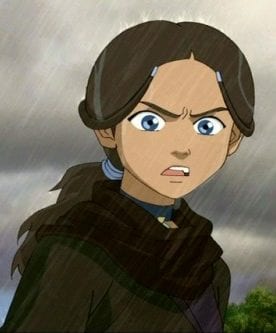To the rejoice of many and concern of some, a new trilogy of Avatar: the Last Airbender has been announced. The previous Avatar comics have had their share of problems. The North and South series, in particular, manages to blunder its way into an endorsement of imperialism. The new Korra comics seem to play it oddly safe, and even in other ATLA comics, like the Promise, the characters we know from the show feel…not quite like themselves.
Do we have reason to hope this time it will be different, and perhaps better? We might, as a new writer, Faith Erin Hicks, is taking over from Gene Yang. I have personally had no experience with her output, but she certainly deserves the benefit of the doubt. Many problems with the ATLA comics to date have in my opinion resulted from Gene Yang simply not understanding the characters—thus we get odd developments like a conservative Katara.
But there’s a very concrete reason to worry, nonetheless. And here’s why, from the description of the new trilogy, Dark Horse “Imbalance”:
“The first part of a new trilogy, this story finds Aang, Katara, Sokka, and Toph dealing with a conflict between benders and non-benders in a booming industrial town.”
The ATLA comics have always been a bridge between the two series, showing us how the world changed from the world Aang fought for, into the world Korra steps into. We saw the United Republic of Nations take shape. And now, we’re about to see the conflict that would form the core of LoK’s first season.
First off, let’s address the elephant in the room: no matter what the Gaang do about the tensions in the comic, they will still erupt into a revolution by the time Legend of Korra begins. This feels like setting them up for failure. Either they tried and failed to ease the tensions, or they just didn’t want to work with the non-benders, instead preserving the status quo that eventually led to the revolt. I really don’t think anyone wants our heroes do the latter (even if it might be in-character for Toph). Aang has shown some uncomfortably bender-centric attitudes in the Promise, but it’s not really something we’d want to see continued either.
The other alternative is that they did their best and smoothed out whatever tensions happened there, but it didn’t stop them from resurfacing some decades later. This seems like a best-case scenario, that doesn’t make them look bad. It helps that we have absolutely no idea what their successors — Tenzin, Lin, the Council or anyone else — actually thought about the problem. Or what they were doing about it. Or… anything else, really.

Which brings me to the other elephant in the room. Legend of Korra dropped the ball on dealing with this topic in just about every way. I have devoted my first article on this site to explaining just how much. Book One: Air introduced a revolution of non-benders, only to gloss over its cause and propose no solutions. Non-benders were as much of a backdrop to benders as ever, if not more.
Now, obviously, it’s not entirely fair to hold it against a new writer producing a new comic series. But it’s also not something we can forget. The franchise tried and failed once. However, there’s not a lot we know about this new attempt, aside from the basic idea. So I’m going to talk about what I  think should happen for this comic to succeed where Legend of Korra failed.
think should happen for this comic to succeed where Legend of Korra failed.
First of all, it needs to give us some real non-bending characters. This is something the comics have actually done before, so we can hope. Obviously, if the person behind them is going to be a bender all along again, this is not going to work, but that… probably won’t happen. Or will it?
We need to see non-benders do things, say things and affect events. Even if ¾ of the cast of protagonists are still benders. The Book One of Korra was a story about benders, despite all the promises and setup. Now we need to see what the world looks like through non-benders’ eyes, and not just Sokka’s.
We don’t know what sort of villain or antagonist the story will have. In LoK, we initially had bending protagonists, with one token non-bender, against a revolution of non-benders. But by the time the first season was over, it was just benders against benders, with the non-benders being no more than puppets.
So what will the comic co? Will there be a single antagonist faction or figure? Or something more complex? I find it likely that the antagonists will end up being some evil benders who had oppressed the non-benders, and the (again, mostly bending) heroes will save the day by defeating them.
Sokka is of course likely to be our foremost voice in this conflict…or should be, anyway. He’s the Gaang’s single non-bender, and his insecurity about it was frequently visible, as were his ways of  making up for his lack of bending. The unhappy non-benders might either see him as an inspiring figure…or someone who pals it up with their bending oppressors.
making up for his lack of bending. The unhappy non-benders might either see him as an inspiring figure…or someone who pals it up with their bending oppressors.
We do also want to see the benders’ perspective, though. What do they think? Aang grew up in a culture where there was no such thing as a non-bender. In the Promise, he assumes the role of authority for the non-bending Air Acolytes. And aside from what, he’s the world’s ultimate bender. Can he empathize with people who might not look at him as their savior, but simply someone with power they’ll never have?
 Katara’s mother was a non-bender and sacrificed herself for her – the tribe’s last waterbender. Would it affect her perspective? Apart from that, Katara has always been acutely aware of other people’s plight, and wanted to help. She is very proud of her bending, though. It was a source of strength and identity for her while her tribe was under attack and on the brink of dying. How would she react to people who oppose it?
Katara’s mother was a non-bender and sacrificed herself for her – the tribe’s last waterbender. Would it affect her perspective? Apart from that, Katara has always been acutely aware of other people’s plight, and wanted to help. She is very proud of her bending, though. It was a source of strength and identity for her while her tribe was under attack and on the brink of dying. How would she react to people who oppose it?
Then Toph’s identity is built around her earthbending and metalbending. How is she going to react to people who might resent the benders for their power? We do know that Toph saw no problems with establishing an exclusively metalbending police force in Republic City, with non-benders apparently relegated to issuing tickets for vagrancy.
They’re also going to need to actually put some effort into the socio-political side of things…something the franchise hasn’t exactly been successful at before. But by picking this conflict, they’ve committed to it. They have to show us what the divide between bender and non-benders actually looks like, on the ground level. Beneath all the magical kung-fu action, weird animal hybrids, and steampunk technology.
Can the comic do that? The last time the ATLA comics tried to tackle politics, the results were… not terribly good. North and South, as I mentioned, ends up with a message that’s unclear at best and rather uncomfortable at worst. Will the same happen here? We can hope not, and it would be unfair to assume the new writer will make the same blunders. But some concern is justified here.
It’s a rather bleak picture of the upcoming comic I painted here. I wish I could be more excited for it, but concerning the past issues and the topic it chose to tackle… I’m hesitant. Let’s hope the new writer is up to the task and proves me wrong.

